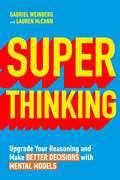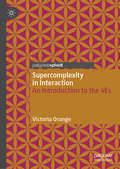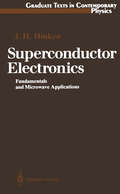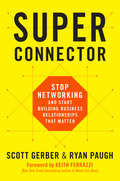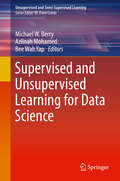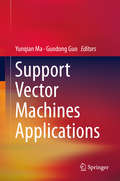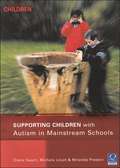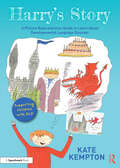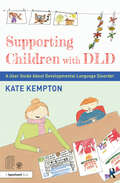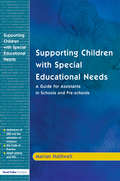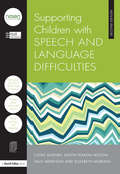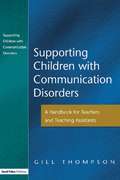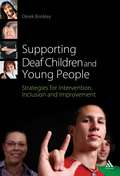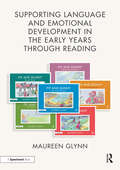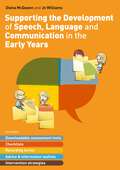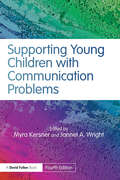- Table View
- List View
Super Thinking: Upgrade Your Reasoning and Make Better Decisions with Mental Models
by Gabriel Weinberg Lauren McCannTurn yourself into a superthinker and make the right decisions every time.You want to make better decisions. You want to be right more of the time-professionally and personally. However, being more right consistently is a hard problem because the world is such a complex, evolving place. How do you navigate this complexity?Mental models are decision making tools that guide our perception of the world and our behaviour in it. They help us understand life, make decisions and solve problems. The best models help us make intelligent investments, develop ground-breaking technologies and even travel to outer space. - Note your frame of reference before debating someone with different political views. If you understand how your perspective contrasts with someone else's you can prevent the conversation from getting hostile.- Apply the sunk cost fallacy to the end of a doomed project. Just because you've put a lot of hours into it doesn't mean that you have to keep going.- Before blaming someone, consider Hanlon's Razor, 'Never attribute to malice that which is adequately explained by carelessness'.- Try to solve mysteries with Occam's Razor, 'Among competing hypotheses, the one with the fewest assumptions should be selected'. When you hear hoof beats, think of horses not zebras.Building on our knowledge of well-known models such as the Bandwagon Effect or Paradigm Shift and introducing us to the lesser known like the Eisenhower Matrix or the Boiling Frog Symbol, this indispensable book distills the most effective mental models into a single, digestible volume. It will make even the most complex models accessible and engaging to enable you to make better, more informed decisions in every part of your life.
Supercomplexity in Interaction: An Introduction to the 4Es
by Victoria OrangeThis book aims to explore the supercomplexity of interaction and to suggest ways of teaching about this supercomplexity in various settings, including intercultural communication and language-learning. Using complex systems theory, the author argues that interaction is actually a supercomplex adaptive system which interconnects a number of different complex systems (the 4Es: Expression, Encounter, Education, Emotion) to give it meaning. She then draws on the concept of heartfulness to promote different ways of understanding and teaching the supercomplexity of interaction. This book will be of interest to language educators and students, as well as scholars of intercultural communication.
Superconductor Electronics: Fundamentals and Microwave Applications (Graduate Texts in Contemporary Physics)
by Johann H. HinkenRecent research on superconductors with high critical temperature has led to results that were not available when the original German edition was prepared but could be included in the present English edition. This concerns materials based on bismuth and thallium, as well as measurements of low microwave loss. The author would like to thank Mr. A. H. Armstrong for translating the book from German to English in a very dedicated and competent manner. Thanks are also due once again to Springer-Verlag for their generous support and cordial cooperation. Bad Salzdetfurth September 1989 Johann H. Rinken Preface to the German Edition The development of materials which lose their electrical resistance when cooled, even before reaching the boiling point of liquid nitrogen, has considerably in creased the interest in superconductor technology, and with it superconductor electronics. This development had not been foreseen when work on the present book started, just over a year ago. Nevertheless, recent results of research on materials with high critical temperature are included to the extent that they seem to be confirmed and to be of interest to superconductor electronics. The present book deals with the physical and technological foundations of superconductor electronics so far as they must be known in order to under stand the principal modes of operation of superconductor electronics components.
Superconnector: Stop Networking and Start Building Business Relationships that Matter
by Scott Gerber Ryan PaughAbandon the networking-for-networking's-sake mentality in favor of a more powerful and effective approach to creating and enhancing connections. STOP NETWORKING. Seriously, stop doing it. Now. It is time to ditch the old networking-for networking's-sake mentality in favor of a more powerful and effective approach to creating and enhancing connections. In Superconnector, Scott Gerber and Ryan Paugh reveal a new category of professionals born out of the social media era: highly valuable community-builders who make things happen through their keen understanding and utilization of social capital. Superconnectors understand the power of relationship-building, problem-solve by connecting the dots at high levels, and purposefully cause different worlds and communities to interact with the intention of creating mutual value. How can you become a Superconnector? Gerber and Paugh share instructive anecdotes from a who's who roster of high achievers, revealing how to systematically manage a professional community and maximize its value. Of utmost importance is practicing Habitual Generosity, acting on the knowledge that your greatest returns come when you least expect them, and that by putting others' needs first the good karma will flow back to you tenfold. Gerber and Paugh also explore winning strategies such as The Art of Selectivity, a well-honed ability to define which relationships matter most for you and decide how you will maintain them over time. Full of helpful advice on how to communicate with anyone about anything, Google-proof your reputation, and much more, Superconnector is a must-read for those seeking personal and business success.
Supervised and Unsupervised Learning for Data Science (Unsupervised and Semi-Supervised Learning)
by Michael W. Berry Azlinah Mohamed Bee Wah YapThis book covers the state of the art in learning algorithms with an inclusion of semi-supervised methods to provide a broad scope of clustering and classification solutions for big data applications. Case studies and best practices are included along with theoretical models of learning for a comprehensive reference to the field. The book is organized into eight chapters that cover the following topics: discretization, feature extraction and selection, classification, clustering, topic modeling, graph analysis and applications. Practitioners and graduate students can use the volume as an important reference for their current and future research and faculty will find the volume useful for assignments in presenting current approaches to unsupervised and semi-supervised learning in graduate-level seminar courses. The book is based on selected, expanded papers from the Fourth International Conference on Soft Computing in Data Science (2018).Includes new advances in clustering and classification using semi-supervised and unsupervised learning;Address new challenges arising in feature extraction and selection using semi-supervised and unsupervised learning;Features applications from healthcare, engineering, and text/social media mining that exploit techniques from semi-supervised and unsupervised learning.
Support Vector Machines Applications
by Yunqian Ma Guodong GuoSupport vector machines (SVM) have both a solid mathematical background and practical applications. This book focuses on the recent advances and applications of the SVM, such as image processing, medical practice, computer vision, and pattern recognition, machine learning, applied statistics, and artificial intelligence. The aim of this book is to create a comprehensive source on support vector machine applications.
Supporting Children with Autism in Mainstream Schools (Supporting Children)
by Diana Seach Michele Lloyd Miranda PrestonIt is increasingly common for children with autism to attend mainstream schools. In this book, the authors use their expertise and considerable experience of working with and observing pupils with autism to exemplify the challenges faced in the classroom. Most importantly, they suggest practical strategies for successfully meeting pupil's learning needs. The case studies bring to life the everyday concerns of young people, their parents and teachers, and provide different contexts for the demonstration of good practice.
Supporting Children with DLD: A Picture Book and User Guide to Learn About Developmental Language Disorder (Supporting Children with DLD)
by Kate KemptonThis picture book and guidebook set has been developed to help raise awareness of Developmental Language Disorder, and to highlight the impact of DLD from the child’s point of view. Harry’s Story introduces a child who faces daily challenges in school due to his language difficulties. It explores how these challenges are made easier by his teachers’ understanding and support as he finds new ways to communicate. Supporting Children with DLD provides essential information, prompts and suggestions for adults to help understand the experience of children with DLD. It offers supportive strategies and activities to help children express themselves effectively and ask for help when they need it. This resource can be used both directly with the child, to talk about and explore DLD, and also as a training tool with the parents and professionals who support them. With research suggesting an average of two children per classroom are affected by DLD, this is an essential set for parents and professionals looking to understand the condition.
Supporting Children with DLD: A User Guide About Developmental Language Disorder (Supporting Children with DLD)
by Kate KemptonFor effective use, this book should be purchased alongside the illustrated picture book Harry’s Story. Both books can be purchased together as a set, Supporting Children with DLD: A Picture Book and User Guide to Learn About Developmental Language Disorder [978-0-367-70920-4]. Supporting Children with DLD, has been developed to help raise awareness of Developmental Language Disorder, and to highlight the impact of the condition from the child’s point of view. With activities, prompts and sample questions, this is an essential resource to enable adults to understand the reality of living with DLD, helping children feel heard and respected, as well as providing a solid foundation for tailoring support to individual needs. Drawing on specific examples from Harry’s Story, the book does not assume any prior knowledge of DLD and is designed to offer the reader accessible information and practical advice, teaching as you go. This book: Highlights the link between spoken and written language, addressing the need to recognise the literary difficulties faced by children with DLD Provides practical activities and worksheets that can be used to help children express themselves and ask for help Offers strategies for supporting children’s understanding of language, based on common situations and experiences explored in Harry’s Story Written to be an accessible introduction to DLD and its effect on children’s lives, this is an essential resource for parents and professionals looking to understand the condition.
Supporting Children with DLD: A User Guide About Developmental Language Disorder (Supporting Children with DLD)
by Kate KemptonFor effective use, this book should be purchased alongside the illustrated picture book Harry’s Story. Both books can be purchased together as a set, Supporting Children with DLD: A Picture Book and User Guide to Learn About Developmental Language Disorder [978-0-367-70920-4]. Supporting Children with DLD, has been developed to help raise awareness of Developmental Language Disorder, and to highlight the impact of the condition from the child’s point of view. With activities, prompts and sample questions, this is an essential resource to enable adults to understand the reality of living with DLD, helping children feel heard and respected, as well as providing a solid foundation for tailoring support to individual needs. Drawing on specific examples from Harry’s Story, the book does not assume any prior knowledge of DLD and is designed to offer the reader accessible information and practical advice, teaching as you go. This book: Highlights the link between spoken and written language, addressing the need to recognise the literary difficulties faced by children with DLD Provides practical activities and worksheets that can be used to help children express themselves and ask for help Offers strategies for supporting children’s understanding of language, based on common situations and experiences explored in Harry’s Story Written to be an accessible introduction to DLD and its effect on children’s lives, this is an essential resource for parents and professionals looking to understand the condition.
Supporting Children with DLD: A Picture Book and User Guide to Learn About Developmental Language Disorder (Supporting Children with DLD)
by Kate KemptonThis picture book and guidebook set has been developed to help raise awareness of Developmental Language Disorder, and to highlight the impact of DLD from the child’s point of view. Harry’s Story introduces a child who faces daily challenges in school due to his language difficulties. It explores how these challenges are made easier by his teachers’ understanding and support as he finds new ways to communicate. Supporting Children with DLD provides essential information, prompts and suggestions for adults to help understand the experience of children with DLD. It offers supportive strategies and activities to help children express themselves effectively and ask for help when they need it. This resource can be used both directly with the child, to talk about and explore DLD, and also as a training tool with the parents and professionals who support them. With research suggesting an average of two children per classroom are affected by DLD, this is an essential set for parents and professionals looking to understand the condition.
Supporting Children with Special Educational Needs: A Guide for Assistants in Schools and Pre-schools
by Marian HalliwellFirst Published in 2004. Routledge is an imprint of Taylor & Francis, an informa company.
Supporting Children with Special Educational Needs: A Guide for Assistants in Schools and Pre-schools
by Marian HalliwellFirst Published in 2004. Routledge is an imprint of Taylor & Francis, an informa company.
Supporting Children with Speech and Language Difficulties (nasen spotlight)
by Hull City CouncilCompletely revised and updated in light of the new SEND 2014 Code of Practice, this new edition describes the different types of difficulties experienced by pupils with speech, language and communication needs. It will help teachers and other professionals to feel more confident by providing expert guidance and practical strategies, and as a professional development tool, will also encourage outstanding practice by suggesting ideas and materials for in-house training sessions. The wide-ranging and accessible chapters explore topics including: Listening skills Phonological awareness Comprehension of language Activities for circle time Working with parents Featuring useful checklists, templates and photocopiable resources, this practical resource contains a wealth of valuable advice and tried-and-tested strategies for identifying children and young people with speech, language and communication needs, ensuring they have the support they need to make exceptional progress.
Supporting Children with Speech and Language Difficulties (nasen spotlight)
by Hull City CouncilCompletely revised and updated in light of the new SEND 2014 Code of Practice, this new edition describes the different types of difficulties experienced by pupils with speech, language and communication needs. It will help teachers and other professionals to feel more confident by providing expert guidance and practical strategies, and as a professional development tool, will also encourage outstanding practice by suggesting ideas and materials for in-house training sessions. The wide-ranging and accessible chapters explore topics including: Listening skills Phonological awareness Comprehension of language Activities for circle time Working with parents Featuring useful checklists, templates and photocopiable resources, this practical resource contains a wealth of valuable advice and tried-and-tested strategies for identifying children and young people with speech, language and communication needs, ensuring they have the support they need to make exceptional progress.
Supporting Communication Disorders: A Handbook for Teachers and Teaching Assistants
by Gill ThompsonThis practical handbook provides SENCOs, class teachers and teaching assistants with a step-by-step guide to the identification of speech and language disorders, a basic knowledge of the underlying causes and guidance for developing strategies for support and intervention in the classroom. It gives a foundation for assessment and differentiation, which will help the teacher or teaching assistant to work effectively in collaboration with speech and language therapists. It suggests appropriate materials and programmes of work for enabling the child to access the curriculum as fully as possible. The book includes photocopiable assessments and worksheets, which can be used as part of planning and intervention for individual children or small group work.
Supporting Communication Disorders: A Handbook for Teachers and Teaching Assistants
by Gill ThompsonThis practical handbook provides SENCOs, class teachers and teaching assistants with a step-by-step guide to the identification of speech and language disorders, a basic knowledge of the underlying causes and guidance for developing strategies for support and intervention in the classroom. It gives a foundation for assessment and differentiation, which will help the teacher or teaching assistant to work effectively in collaboration with speech and language therapists. It suggests appropriate materials and programmes of work for enabling the child to access the curriculum as fully as possible. The book includes photocopiable assessments and worksheets, which can be used as part of planning and intervention for individual children or small group work.
Supporting Deaf Children and Young People: Strategies for Intervention, Inclusion and Improvement (Supporting Children)
by Derek BrinkleyThe majority of deaf children are taught in the mainstream system, but are much more likely to underachieve at school than their hearing counterparts. Supporting Deaf Children and Young People is a comprehensive guide to working with deaf and hearing-impaired students in a variety of educational settings. The book features an overview of current areas of controversy and difficulty within deaf education, as well as offering practical advice and strategies for supporting deaf individuals, such as • raising literacy and numeracy standards • identifying and circumventing avoidance strategies • incorporating deaf-friendly resources and activities into lesson plans• working with parents and other professionals. The book also includes advice on aids and technology, as well as looking at the social and emotional side of being a deaf student today. The supportive and positive voice of the author will help readers analyze and reflect on their teaching in order to find their own solutions to supporting their students.
Supporting Deaf Children and Young People: Strategies for Intervention, Inclusion and Improvement (Supporting Children)
by Derek BrinkleyThe majority of deaf children are taught in the mainstream system, but are much more likely to underachieve at school than their hearing counterparts. Supporting Deaf Children and Young People is a comprehensive guide to working with deaf and hearing-impaired students in a variety of educational settings. The book features an overview of current areas of controversy and difficulty within deaf education, as well as offering practical advice and strategies for supporting deaf individuals, such as • raising literacy and numeracy standards • identifying and circumventing avoidance strategies • incorporating deaf-friendly resources and activities into lesson plans• working with parents and other professionals. The book also includes advice on aids and technology, as well as looking at the social and emotional side of being a deaf student today. The supportive and positive voice of the author will help readers analyze and reflect on their teaching in order to find their own solutions to supporting their students.
Supporting Grammar and Language Development in Children: A Guidebook for the Grammar Tales Stories (Grammar Tales)
by Jessica HabibThis guidebook has been created to accompany the Grammar Tales story books, a collection of beautifully illustrated picture books designed to support grammar and language development in children. Including accessible activities and ideas to help children use grammar forms expressively, the guidebook discusses the specific grammatical form focused on in each story, and offers support in using the storybooks effectively. Photocopiable and downloadable handouts for parents and carers allow therapy work to continue beyond the therapy session. This guidebook is an essential accompaniment to the Grammar Tales storybooks for Speech and Language therapists working with children.
Supporting Grammar and Language Development in Children: A Guidebook for the Grammar Tales Stories (Grammar Tales)
by Jessica HabibThis guidebook has been created to accompany the Grammar Tales story books, a collection of beautifully illustrated picture books designed to support grammar and language development in children. Including accessible activities and ideas to help children use grammar forms expressively, the guidebook discusses the specific grammatical form focused on in each story, and offers support in using the storybooks effectively. Photocopiable and downloadable handouts for parents and carers allow therapy work to continue beyond the therapy session. This guidebook is an essential accompaniment to the Grammar Tales storybooks for Speech and Language therapists working with children.
Supporting Language and Emotional Development in the Early Years through Reading (Supporting Language and Emotional Development in the Early Years through Reading)
by Maureen GlynnThis invaluable resource comprises a set of six ‘Pip and Bunny’ picture books with accompanying professional guide and downloadable online content; all carefully written and illustrated to support language and emotional development through reading. By inspiring conversation and fueling the young reader’s imagination the books promote emotional and social literacy. Designed for use within the Early Years setting or at home, each story explores different areas of social and emotional development. The full set includes: Six beautifully illustrated picture books with text and vocabulary for each A handbook designed to guide the parent or practitioner in using the books effectively ‘Talking Points’ relating to the child’s own world ‘What’s the Word?’ picture pages to be photocopied, downloaded or printed Detailed suggestions as to how to link with other EYFS areas of learning The set is designed to be used in both individual and group settings, and at various stages of a child’s development. It will be a valuable resource for teachers, SENCOs ( pre-school and reception), Early Years workers, EOTAs, Educational Psychologists, Counsellors and therapists.
Supporting the Development of Speech, Language and Communication in the Early Years: Includes Downloadable Assessment Tools, Checklists, Recording Forms, Advice and Information Leaflets and Intervention Strategies
by Diana McQueen Jo WilliamsSpeech and language impairment can have a huge impact on cognitive development. Identifying what is going wrong - and what effective intervention looks like - can be daunting. Short of retraining you as a speech and language therapist, this thorough guide will give you everything you need to change that.An essential resource, the book contains a wide variety of online resources, including phonological and sound awareness documents, assessment tools, and recording forms that can be downloaded straight to your device, providing excellent materials and activities to use in the classroom.Written by speech and language therapists and designed exclusively for Early Years practitioners, this book provides a complete overview of how children acquire language and what language impairments look like at this age. You will find both strategic and practical advice on how to manage and encourage the development of speech and language skills. Creating the optimum communication environment for every child in your setting is an important part of what the book offers. Equally, practitioners are supported to be able to recognise the features of specific language difficulties such as Developmental Language Disorder (DLD) and feel confident to intervene when children are struggling.
Supporting Young Children with Communication Problems
by Myra Kersner Jannet A. WrightNow in its fourth edition, formerly published as How to Manage Communication Problems in Young Children, this invaluable guide to understanding and helping children whose speech and/or language is delayed or impaired has been completely revised and updated, and provides readers with: Practical advice on how to recognise communication problems Strategies for supporting children with speech, language and communication needs Best practice guide for parents and professionals working in partnership Contributions from a wide-range of specialist speech and language therapists Reflecting new developments and current practice, this book is of interest to parents, early years’ practitioners, students in education and speech and language therapy, and anyone interested in pursuing a career with young children in the foundation years. Written in an accessible style, it assumes no prior knowledge and includes a range of practical suggestions for dealing with children with all kinds of communication difficulties.
Supporting Young Children with Communication Problems
by Myra Kersner Jannet A. WrightNow in its fourth edition, formerly published as How to Manage Communication Problems in Young Children, this invaluable guide to understanding and helping children whose speech and/or language is delayed or impaired has been completely revised and updated, and provides readers with: Practical advice on how to recognise communication problems Strategies for supporting children with speech, language and communication needs Best practice guide for parents and professionals working in partnership Contributions from a wide-range of specialist speech and language therapists Reflecting new developments and current practice, this book is of interest to parents, early years’ practitioners, students in education and speech and language therapy, and anyone interested in pursuing a career with young children in the foundation years. Written in an accessible style, it assumes no prior knowledge and includes a range of practical suggestions for dealing with children with all kinds of communication difficulties.
